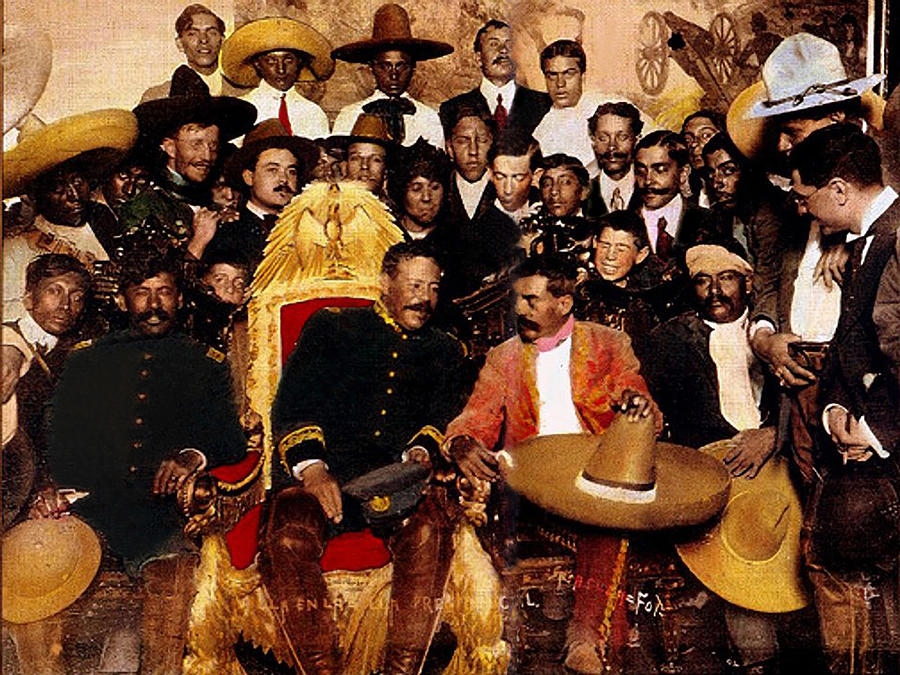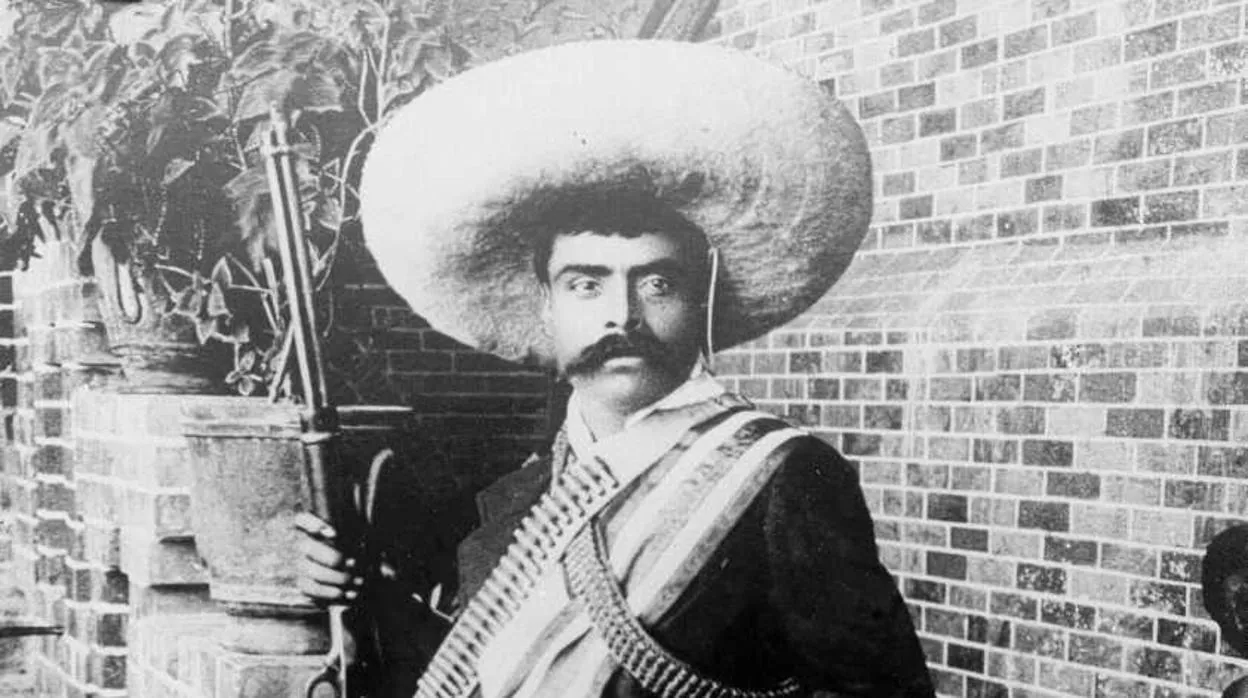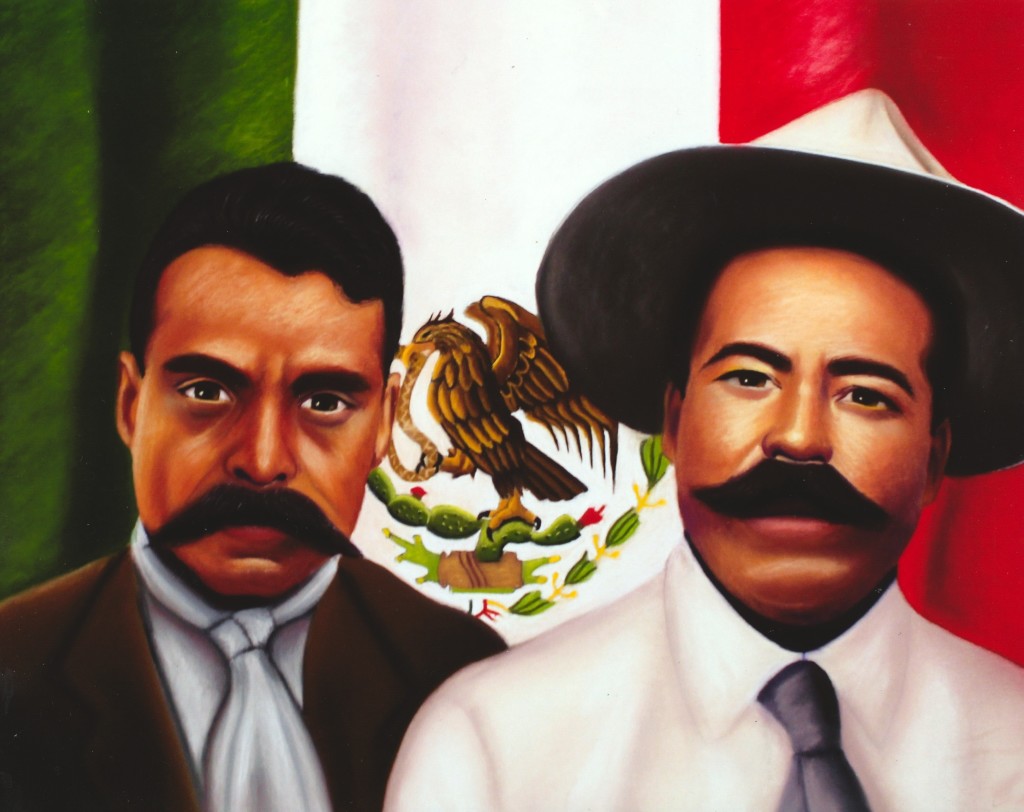
6 Diciembre 1914 Las tropas de Pancho Villa y Emiliano Zapata ocupan el Palacio Nacional
Francisco "Pancho" Villa ( b. 5 June 1878; d. 20 July 1923), Mexican revolutionary, general, governor of Chihuahua (1913-1915). Christened Doroteo Arango, one-time bandit and muleteer, Villa became one of the most important and controversial leaders of the Mexican Revolution (1910-1920). The history of Villa's youth is masked in legend.

Pancho Villa & Emiliano Zapata Mexico history, Mexican revolution, Pancho villa
Emiliano Zapata. Emiliano Zapata Salazar ( Spanish pronunciation: [emiˈljano saˈpata]; August 8, 1879 - April 10, 1919) was a Mexican revolutionary. He was a leading figure in the Mexican Revolution of 1910-1920, the main leader of the people's revolution in the Mexican state of Morelos, and the inspiration of the agrarian movement called.

"pancho Villa Y Emiliano Zapata", Impressionist Drawing/illustration for sale by odettevalero
Pancho Villa´s personality has been controversial since the very beginning of his career as a General of the revolutionary army. A little more than 100 years ago a Mexican peasant named Emiliano Zapata gathered a rural army from the plantations and villages of southern Mexico, seized the lands of the haciendas, and began to distribute them among the peasants of Anenecuilco, his hometown, in.

Descubren romance secreto entre Pancho Villa y Emiliano Zapata El Dizque
The "Big Four" leading warlords in the field -- Venustiano Carranza, Alvaro Obregon, Pancho Villa and Emiliano Zapata -- were united in their hatred of Orozco and Huerta and together they crushed them. By 1914, Huerta and Orozco were gone, but without them to unite these four powerful men, they turned on one another.

The deadliest war in North America's modern history started 105 years ago today Business Insider
Summary []. Los jefes de la División del Norte y del Ejército del Sur, los generales Pancho Villa y Emiliano Zapata, acompañados de los generales Tomás Urbina, Rodolfo Fierro, Rafael Buelna y otros más, a su paso por la avenida Plateros (hoy Madero), el 6 de diciembre de 1914, en la ciudad de México.

Pancho Villa In Presidential Chair And Emiliano Zapata Palacio Nacional Mexico City December 6
Francisco I. Madero and his presidential Staff Meanwhile, Emiliano Zapata, proposing land reformation that would end the sort-of-feudal system that pervaded in the country, rose in the south. Francisco 'Pancho' Villa, alongside Abraham González, mobilized in the north in Chihuahua, later on joined by Pascual Orozco (Madero joined them soon too).

Pancho Villa Y Emiliano Zapata Dibujo
When Emiliano Zapata insisted Villa join him in a toast when their two armies met outside Mexico City in December 1914, Villa gagged on a swig of brandy. He was an avid swimmer and would run to stay in shape. According to one of Villa's last surviving widows, he officially married 26 times. A split among the revolutionary leaders soon pitted.

Zapata y Pancho villa Revolución mexicana, Obras de arte mexicano, Heroes de mexico
Rebel leaders Pancho Villa, Emiliano Zapata, Venustiano Carranza and Álvaro Obregón met at Aguascalientes to discuss the nation's future, but the talks went badly. On 4 December 1914, Villa and Zapata met in Xochimilco, a small town just outside of Mexico City, to settle their differences and form a more stable and cohesive alliance.

Top 113 + Imagenes de pancho villa y zapata
At that original convention, the followers of Emiliano Zapata and those of Francisco "Pancho" Villa formed an alliance, which was consolidated when Zapata and Villa met in Mexico City in December of that same year.. Pablo Torres Burgos y Emiliano Zapata mártires, hasta la restauración de la reacción por Vicente Estrada.

Seated, from left to right, Pancho Villa, Eulalio Gutíerrez, Emiliano Zapata and Felícitas
Francisco "Pancho" Villa was the other iconic Mexican revolutionary who, with his northern division (División del Norte), fought against Porfirio Díaz's regime and then took the stance against Huerta's usurpation of power after La Decena Trágica (The Ten Tragic Days). His real name was Doroteo Arango, but he has become known as El Centauro del Norte.

De qué hablaron Pancho Villa y Zapata cuando se encontraron en Ciudad de México Flipr
Public domain. S hortly after the sun rose on April 10th, about a week and a half before Easter, Emiliano Zapata was already awake and riding his horse. He rode along the cool countryside with the.

Pancho Villa y Emiliano Zapata la revolución en el desierto de México
Pancho Villa. Pancho Villa (1878-1923) was a famed Mexican revolutionary and guerilla leader. He joined Francisco Madero's uprising against Mexican President Porfirio Díaz in 1909, and later.

Pancho Villa and Emiliano Zapata together again in Mexico City YouTube
Luchador social, bandolero, revolucionario, violento e implacable. Es la historia de Pancho Villa, uno de los personajes más icónicos de la Revolución Mexicana y también el único.

emiliano zapata and pancho villa Субвенције у пољопривреди
Emiliano Zapata (born August 8, 1879, Anenecuilco, Mexico—died April 10, 1919, Morelos) Mexican revolutionary, champion of agrarianism, who fought in guerrilla actions during and after the Mexican Revolution (1910-20).. Early career. Zapata was the son of a mestizo peasant who trained and sold horses. He was orphaned at the age of 17 and had to look after his brothers and sisters.

PANCHO VILLA & EMILIANO ZAPATA VINTAGE NEGATIVE & PHOTO circa 1912 MEXICO CITY** 1867141870
The second photograph depicts Emiliano Zapata and Pancho Villa in the national palace following their attack on Mexico City. In February of the previous year (1913), attacks had begun on Mexico City and the national palace. These became the "ten tragic days" in which supporters for Madero battled those against him.

Pancho Villa y Zapata entrando triunfantes a Ciudad de México. Mexico history, Mexican
El ejército de campesinos de Pancho Villa y Emiliano Zapata, fotografiado alrededor del año 1910. Los zapatistas afirmaron que el presidente, el principal impulsor de la Revolución,.